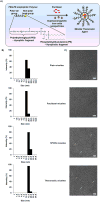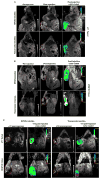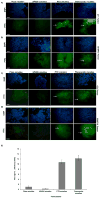Polymeric micelles: Theranostic co-delivery system for poorly water-soluble drugs and contrast agents
- PMID: 29649747
- PMCID: PMC5918157
- DOI: 10.1016/j.biomaterials.2018.03.054
Polymeric micelles: Theranostic co-delivery system for poorly water-soluble drugs and contrast agents
Abstract
Interest in theranostic agents has continued to grow because of their promise for simultaneous cancer detection and therapy. A platform-based nanosized combination agent suitable for the enhanced diagnosis and treatment of cancer was prepared using polymeric polyethylene glycol-phosphatidylethanolamine-based micelles loaded with both, poorly soluble chemotherapeutic agent paclitaxel and hydrophobic superparamagnetic iron oxide nanoparticles (SPION), a Magnetic Resonance Imaging contrast agent. The co-loaded paclitaxel and SPION did not affect each other's functional properties in vitro. In vivo, the resulting paclitaxel-SPION-co-loaded PEG-PE micelles retained their Magnetic Resonance contrast properties and apoptotic activity in breast and melanoma tumor mouse models. Such theranostic systems are likely to play a significant role in the combined diagnosis and therapy that leads to a more personalized and effective form of treatment.
Keywords: Cancer therapy; Diagnostics; Drug delivery; Micelles; Nanoparticles; Theranostics.
Copyright © 2018 Elsevier Ltd. All rights reserved.
Figures






Similar articles
-
Theranostic Application of Mixed Gold and Superparamagnetic Iron Oxide Nanoparticle Micelles in Glioblastoma Multiforme.J Biomed Nanotechnol. 2016 Feb;12(2):347-56. doi: 10.1166/jbn.2016.2173. J Biomed Nanotechnol. 2016. PMID: 27305768 Free PMC article.
-
The theranostic efficiency of tumor-specific, pH-responsive, peptide-modified, liposome-containing paclitaxel and superparamagnetic iron oxide nanoparticles.Int J Nanomedicine. 2018 Mar 13;13:1495-1504. doi: 10.2147/IJN.S157082. eCollection 2018. Int J Nanomedicine. 2018. PMID: 29559778 Free PMC article.
-
Superparamagnetic Iron Oxide Nanorod Carriers for Paclitaxel Delivery in the Treatment and Imaging of Colon Cancer in Mice.J Biomed Nanotechnol. 2016 Sep;12(9):1734-45. doi: 10.1166/jbn.2016.2283. J Biomed Nanotechnol. 2016. PMID: 29345885
-
Magnetic nanoparticles for precision oncology: theranostic magnetic iron oxide nanoparticles for image-guided and targeted cancer therapy.Nanomedicine (Lond). 2017 Jan;12(1):73-87. doi: 10.2217/nnm-2016-0316. Epub 2016 Nov 23. Nanomedicine (Lond). 2017. PMID: 27876448 Free PMC article. Review.
-
Nanotheranostic Pluronic-Like Polymeric Micelles: Shedding Light into the Dark Shadows of Tumors.Mol Pharm. 2019 Dec 2;16(12):4757-4774. doi: 10.1021/acs.molpharmaceut.9b00945. Epub 2019 Nov 1. Mol Pharm. 2019. PMID: 31633939 Review.
Cited by
-
Mannose Ligands for Mannose Receptor Targeting.Int J Mol Sci. 2024 Jan 23;25(3):1370. doi: 10.3390/ijms25031370. Int J Mol Sci. 2024. PMID: 38338648 Free PMC article. Review.
-
Potential of Nanocarrier-Based Drug Delivery Systems for Brain Targeting: A Current Review of Literature.Int J Nanomedicine. 2021 Nov 11;16:7517-7533. doi: 10.2147/IJN.S333657. eCollection 2021. Int J Nanomedicine. 2021. PMID: 34795481 Free PMC article. Review.
-
Hyaluronic acid reduction-sensitive polymeric micelles achieving co-delivery of tumor-targeting paclitaxel/apatinib effectively reverse cancer multidrug resistance.Drug Deliv. 2020 Dec;27(1):825-835. doi: 10.1080/10717544.2020.1770373. Drug Deliv. 2020. PMID: 32489129 Free PMC article.
-
Magnetic Nanoparticles as MRI Contrast Agents.Top Curr Chem (Cham). 2020 May 7;378(3):40. doi: 10.1007/s41061-020-00302-w. Top Curr Chem (Cham). 2020. PMID: 32382832 Free PMC article. Review.
-
SARS-CoV-2 and its new variants: a comprehensive review on nanotechnological application insights into potential approaches.Appl Nanosci. 2023;13(1):65-93. doi: 10.1007/s13204-021-01900-w. Epub 2021 Jun 10. Appl Nanosci. 2023. PMID: 34131555 Free PMC article. Review.
References
-
- MacKay JA, Li Z. Theranostic agents that co-deliver therapeutic and imaging agents? Adv Drug Deliv Rev. 2010;62(11):1003–4. - PubMed
-
- Maeda H, Wu J, Sawa T, Matsumura Y, Hori K. Tumor vascular permeability and the EPR effect in macromolecular therapeutics: a review. J Control Release. 2000;65(1–2):271–84. - PubMed
-
- Hahn MA, Singh AK, Sharma P, Brown SC, Moudgil BM. Nanoparticles as contrast agents for in-vivo bioimaging: current status and future perspectives. Anal Bioanal Chem. 2011;399(1):3–27. - PubMed
Publication types
MeSH terms
Substances
Grants and funding
LinkOut - more resources
Full Text Sources
Other Literature Sources

